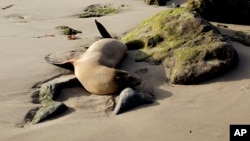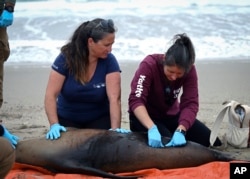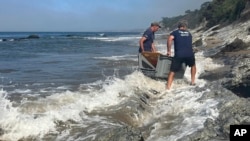A California wildlife organization says it has been rescuing sick sea lions in recent weeks showing signs of algae poisoning.
On August 1, the Santa Barbara-based Channel Islands Marine & Wildlife Institute said teams had rescued at least 23 animals. The U.S. Vandenberg Space Force Base recently released photos on social media of sea lions being taken from one of its beaches.
The institute said that since July 26, it had received numerous reports daily of sick lions along a 250-kilometer stretch of coastline in Santa Barbara and Ventura counties.
The group said in a statement the sea creatures were found to be suffering from the effects of domoic acid, a poison that can harm the brain and heart. The release of the acid in a large ocean event is known as an algae bloom.
The poison is produced by microscopic algae eaten by shellfish or small fish. Those shellfish or fish are often then eaten by sea lions, dolphins or birds. The algae can also sicken humans.
Among the signs of sickness experienced by affected sea lions are unusual head movements, disorientation, foaming at the mouth and seizures.
In a message published on Facebook August 4, the institute said the poisoning event was “heating up,” with new cases of sick sea lions still appearing at multiple beaches. It explained that rescue teams first try to get the animals in a net so they can be transported for treatment and then returned to the sea.
The U.S. National Oceanic and Atmospheric Administration (NOAA) says poisoning events linked to domoic acid are common along the California coast. Experts said the latest poisoning event seems to mostly be affecting adult female sea lions.
Last year, an especially severe poisoning event killed hundreds of sea lions and a number of dolphins during the first weeks of June.
I’m Bryan Lynn.
The Associated Press reported this story. Bryan Lynn adapted the report for VOA Learning English.
_____________________________________________
Words in This Story
algae - n. a plant with no stem or leaves that grows in or near water
bloom – v. to become densely populated with microorganisms such as algae
disorient – v. to make someone confused or unsure











Forum